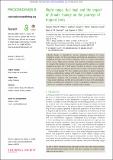Flight range, fuel load and the impact of climate change on the journeys of migrant birds
Abstract
Climate change is predicted to increase migration distances for many migratory species, but the physiological and temporal implications of longer migratory journeys have not been explored. Here, we combine information about species' flight range potential and migratory refuelling requirements to simulate the number of stopovers required and the duration of current migratory journeys for 77 bird species breeding in Europe. Using tracking data, we show that our estimates accord with recorded journey times and stopovers for most species. We then combine projections of altered migratory distances under climate change with models of avian flight to predict future migratory journeys. We find that 37% of migratory journeys undertaken by long-distance migrants will necessitate an additional stopover in future. These greater distances and the increased number of stops will substantially increase overall journey durations of many long-distance migratory species, a factor not currently considered in climate impact studies.
Citation
Howard , C , Stephens , P A , Tobias , J A , Sheard , C , Butchart , S H M & Willis , S G 2018 , ' Flight range, fuel load and the impact of climate change on the journeys of migrant birds ' , Proceedings of the Royal Society B: Biological Sciences , vol. 285 , no. 1873 , 20172329 . https://doi.org/10.1098/rspb.2017.2329
Publication
Proceedings of the Royal Society B: Biological Sciences
Status
Peer reviewed
ISSN
0962-8452Type
Journal article
Description
Collection of biometric data was supported by the Natural Environment Research Council (NE/I028068/1) to JAT and the USUK Fulbright Commission and the Oxford Clarendon Fund to C.S. This research was funded by a Durham University Seedcorn grant to SGW. Production of the underlying SDMs was funded by a National Environment Research Council training grant (NE/J500215/1).Collections
Items in the St Andrews Research Repository are protected by copyright, with all rights reserved, unless otherwise indicated.

